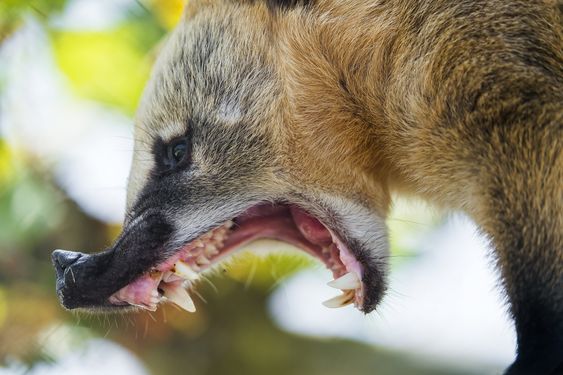
[ad_1]
Coati is the less researched animal, that is why its many facets are still the dark, but we are covering every single topic about coatimundis as fast as possible. Coati teeth are also one of the most searched queries about these inquisitive animals (coatis).
An adult coati owns almost 40 teeth, including incisors, canines, premolars, and molars. Their teeth are present in a variety of morphs (shapes) due to their omnivore lifestyle. They use scissors for grabbing, canines for tearing, and premolars and molars for crushing and grinding their food.
Fact: The male coatimundi has bigger canines rather than female coatis.
Further, below a short guide is provided to make it easy for you to remember the function and morphs of the teeth of these little curious creatures.
Incisors
Incisors are the most common type of teeth in beings. These teeth are found in frontal row of teeth and are very helpful when it comes to crush or grab any fruit.
These teeth also help coatis when they try to break the exoskeleton of plant materials such as fruits and nuts.
Note: Coati owns 12 incisor teeth that are collectively enough for grabbing.
Canines
Canines are the most famous teeth kind in meat eating animals. These teeth found just after the incisors and before premolars. Their morph is pointed (every wild lover knows), and this helps coatimundis to tear prey into pieces.
Further, these teeth of coatimundis are not limited at above. They are territorial animals and often fight against each other for their territories. They also fight in mating season, where their canine’s teeth are their most used tools to win the fight.
Note: Coati owns 4 canine teeth, two on the above and two on the beneath side of their frontal jaw.
Premolars
This teeth type is surrounded by canines and molars. In variety, these teeth are not limited because they can be pointed as well as blade-like sharp that depends on their fighting behavior; they adopted from early life.
These teeth collections help coatis to both grind and crush their food.
Note: The number of their premolar teeth is 16.
Molars
These are the basic teeth kind that are essential for every creature who eats food. Molars allow to grind food (especially nuts and fruits with hard exoskeletons) into small pieces (easily digestible) that make it suitable for the stomach.
Further, they are flat and broad in morph while found at the very end part of the jaw.
Note: Coati owns 8 molars teeth that are enough strong to grind food in small pieces.
Why Teeth In Such Variations Necessary For Coati?
To Survive In the Wild
There are multiple coati predators roaming in the forest. Bigger cats, jaguars, jackels, wolves, e.t.c are all stay alert to hunt them. So, these coatis need some adaptations to survive in such a horror environment.
The teeth of coatis help them in fighting for their survival. For example, they can attack any delicate part of their predator that allows them some time to escape from it. Their canines and their claws are very beneficial tools for them in case of any encounter with predators.
Note: There is very low chance of a coati to escape from a predator with the help of teeth while they can use their agility and ability to climb trees to disappear from predator eyesight.
To Protect Their Territory
Coatis are territorial animals, and they need to protect their territory in any way. So, they often fight each other to win other’s territories or to protect their own.
For Mates
In mating season, they also fight each other to impress female coatis. Their teeth also play a crucial role to win this fight.
Note: Canine teeth are so much important when it comes to fight each other, even, the coati with long canines can have an extra pressure on other one with smaller canines.
To Eat A Diverse Diet
We wrote a post in which we covered the topic about coati diet. In this post, we explain that the coatis are very amazing in eating. They eat diverse food, including juicy fruits (mangoes, bananas), leaves, insects, and smaller invertebrates.
To enjoy all that they need, such as variations in their teeth that help them to grab, slice, tear, crush, and grind their food. So, they have such variation and also enjoying the food, they love.
How Coatis Take Care Of Their Teeth In Wild?
Like every other creature, nature provides them every necessary information to survive in the wild. When it comes to coati dental care in the wild, they use different techniques to ensure it.
First of all, they eat plant material like leaves, which are very beneficial to remove plaque and tartar from teeth. Fruits with high levels of juice also remove debris or remains of food from teeth.
Eating wood is also a fascinating technique for wild creatures that maintain their dental care as well as strengthen their teeth.
Coati Teeth Facts
- Coati began to get their first milk teeth (incisors) just after 2 weeks of their birth.
- After 4 weeks of a coati birth, their milk teeth canines erupt but it takes almost 9 months to erupt adult canines.
- The strongest coati biting force is 83 Newtons, and this bite force is of White-nosed coati. Thanks to their strong jaw muscles, strong teeth, and extra enamel coat on their teeth.
- They have naturally strong molars that can crush nuts without damaging themselves.
[ad_2]
Source link

Leave a Reply